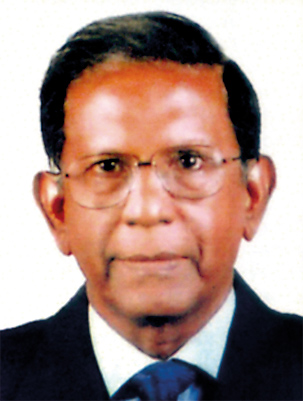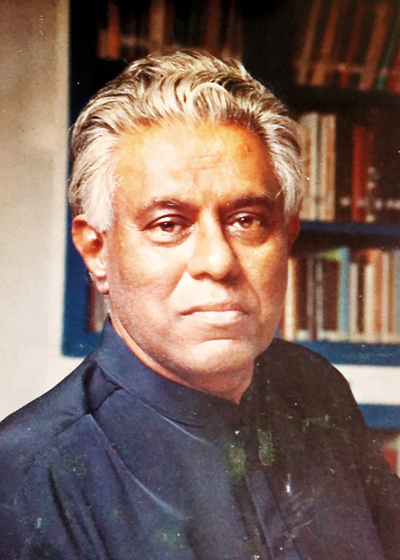Appreciations
View(s):Dr. Navaratnam Yogaratnam
A great scientist and true friend
Dr. Navaratnam Yogaratnam was a qualified and experienced tree crop specialist with over 40 years experience both in plantation and smallholder agriculture.
He worked as Rubber Consultant, Deputy Director (Research), Tree Crops Agronomist, Human Resources Developer, Project Co-ordinator in the public and private sector, domestic and international organisations in Sri Lanka, Zambia, Malaysia and the UK in several programmes of international agencies; IDA/ World Bank, FAO, IAEA, ADB, CIDA, SIDA, IRRDB and JICA and was the Editor of technical and business publications.
A graduate in agriculture of the University of Allahabad, he obtained his PhD in 1975 in Tree Crop Nutrition from the University of London for his thesis on the “Effects of nutrient sprays on fruit set, mineral composition and fruit quality of apple”.
He joined the Rubber Research Institute in 1969 as an Assistant Soils Chemist and then functioned as an Agronomist until 1976 when he was appointed as the Head of the Soils and Plant Nutrition Department.
He did pioneering research into the use of urea as a nitrogenous fertilizer for rubber, Eppawala rock phosphate as a source of phosphate for rubber, water soluble liquid formulations of fertilizers for young budding nursery plants and also on inter-planting of rubber with tea.
His other significant contributions are, increasing fertilizer use efficiency and perfecting of the technique of site specific fertilizer recommendations based on soil and foliar analysis, all of which result in an annual saving of several million rupees in the fertilizer cost of mature plantings.
Also, he formulated herbicide formulations as substitute to sodium arsenite for weed control under rubber, when the use of sodium arsenite was banned in Sri Lanka.
He was a member of the research team that received the National Award for Scientific Achievement in 1990. He published over 100 scientific articles most of them on Rubber Agronomy.
He worked as a Tree Crop Agronomist for the Ministry of Agriculture and Water Development, Republic of Zambia, as a Fertilizer Consultant in Malaysia, as a Soil Science and Agronomy Consultant to a World Bank financed project on Forestry Development and on Tea Agronomy at the Tea Research Institute for a short period prior to joining the PRISL.
He was actively involved in other agronomy and soil science related activities also and was the President of the Indian Society of Agronomy, Allahabad Branch, in 1962 and 1963 and the President of the Soil Science Society of Sri Lanka, which is affiliated to the International Soil Science Society (ISSS), in 1993 and 1994.
He was promoted at the PRISL to the post of the Assistant Director in 1988 and in 1992 was appointed the Deputy Director (Research) until his retirement in 1999.
Then he joined the Institute of Plantation Management (NIPM) as a consultant. He provided consultancy and advisory to many plantation companies. Scientists as well as the plantation community benefited from his knowledge, expertise and guidance.
He was freelance writer, writing technical and business articles to the Financial Times, the Daily Mirror and the Sunday Times and Financial News of the Daily News, regularly.
Dr. Yogaratnam was full of human qualities and it is hard to find somebody at the RRISL who has not been helped by him.
He was a highly principled, cultured and courteous gentleman.
The respect he earned over 30 years period at RRISL means that we all will mourn the passing of a compassionate man.
Though he was 76 when he died, we all feel that he died too early as he was actively involved and helped us in our research as an excellent editor.
The scientific community of Sri Lanka lost an outstanding scientist and an inspiring friend. The memory of such good men, even in death, must remain a part of our lives.
Dr. Yogaratnam is survived by his wife Padmini, daughter Geetha and two grandchildren Arjun and Anika.
-Dr.(Mrs.) Priyani Seneviratne
Senake Dias Bandaranayake
The man who shaped the contours of Lanka’s contemporary archaeology
Professor Senake Dias Bandaranayake, one of the senior most and outstanding archaeologists of South Asia by all standards, passed away in his sleep in Colombo on March 2 this year.
While battling bravely over many years with debilitating health problems arising from Parkinson’s disease, Bandaranayake continued till the end his multi-sided and highly rated contributions to the archaeology as well as art and architectural history of Sri Lanka and played an important role in shaping the contours of contemporary archaeology of the island nation.
Born into one of the well-known and highly influential families of Sri Lanka, Bandaranayake received his college education from St. Thomas’s College, Mount Lavinia near Colombo, and then left for the U.K. for higher studies.
After completing a B.A. (Hons.) degree in English from Bristol University, he shifted to Oxford University.
There commenced his life-long commitment to Sri Lanka’s heritage studies with a B.Litt thesis in 1965 on the vaulted brick image-houses of Polonnaruva.
He followed it up with a comprehensive and fieldwork-based D.Phil. thesis on the Buddhist viharas of the island’s first capital at Anuradhapura (published as Sinhalese Monastic Architecture by E.J. Brill, 1974).
Bandaranayake returned to Sri Lanka in 1974 and in the next four decades he played the role of a true catalyst.
Modern archaeological studies in the country fully benefited from his firm grasp of the latest trends in archaeology, his widely acclaimed organisational abilities and, above all, his keen desire to highlight the innovative dimensions of the development of the island’s cultural heritage against the wider South Asian background.
Appointed in 1975 on the faculty of Kelaniya University’s Department of Archaeology, he introduced new teaching and research programmes and built up an excellent cadre of young workers in archaeology and art history.
Helping his colleagues to publish works on temple paintings, mask systems and other topics, he himself completed an admirable work of synthesis entitled Sri Lanka – Island Civilization (translated into many other languages).
In the 1980s and 1990s Sri Lankan archaeology witnessed true resurgence.
Toward this end the efforts of Roland Silva as the Director General of the Government Department and those of Siran Deraniyagala as an expert in prehistory and protohistory were ably complemented by Bandaranayake’s own contributions as an expert in historical archaeology and art history.
Together they trained cadres of young field archaeologists and, more importantly, invited foreign teams from America and Europe to collaborate in fresh excavations initiated at various Stone Age sites in the central hills and at Sigiriya, Anuradhapura, Mantai and other famous historical sites.
These efforts were ably supported by the UNESCO and Ford Foundation. And Sri Lankan archaeology made its name felt loudly at the global level.
Bandaranayake played a major part in this process by directing a long-term Cultural Triangle field project concerning settlement archaeology of the Sigiriya-Dambulla region.
Rising above the old monument-centred approach, he and his team adopted a regional strategy, obtained valuable small-site record containing information about various production systems linked to the main sites and also recorded an enormous amount of ethnoarchaeological and ethnohistorical information.
The two volumes entitled Settlement Archaeology of the Sigiriya-Dambulla Region (1990, 1994) which he and his team published on these field studies are an outstanding example of landscape archaeology, as applied to the historical period in the entire Old World.
Alongside these and other field studies, Bandaranayake founded in 1986 the Postgraduate Institute of Archaeology in Colombo for imparting advanced training in archaeological method and theory.
He served as the Vice-Chancellor of the University of Kelaniya from 1997 to 1999 and was then posted as the ambassador of Sri Lanka to France and as its permanent delegate at the UNESCO.
From an early part of his career he maintained close contacts with other South Asian archaeologists. He stoutly maintained the individuality of Sri Lanka’s long cultural trajectory, but without denying its generic relationship with the South Asian regional oikoumène.
India held a special place in Bandaranayake’s mind. He visited it on several occasions and had close contacts with several senior scholars such as M.S. Nagaraja Rao, M.K. Dhavalikar, V.N. Misra, and A.P. Jamkhedkar, some of whom he had invited to Sri Lanka on lecture-tours.
Several staff members from the Deccan College in Pune participated in the various excavations in Sri Lanka. Also a large number of Sri Lankan students received their training in archaeological and linguistic studies at the Deccan College and these links still continue.
During his posting to New Delhi as Sri Lanka’s High Commissioner and as Ambassador to Bhutan from 2000 to 2002, Bandaranayake further strengthened the connections among South Asian archaeologists.
Among other things, he successfully persuaded Virchand Dharamsay of Mumbai to prepare a biography of the famous nineteenth-century Indologist of Western India, Bhagawanlal Indraji, and himself wrote a moving foreword to it.
I have a three-decade-long personal friendship with Bandaranayake and his wife Manel.
I recall with gratitude the week-long tour of mine to Sri Lanka which he sponsored in August 1991 for giving a series of lectures in archaeological theory at the Institute of Archaeology, followed by memorable visits to Kandy, Anuradhapura, Dambulla, Sigiriya and Polonnaruva.
I cherish the wonderful hospitality and amiability of the Bandaranayake couple.
Bandaranayake has published about a dozen books and over a hundred research papers on various aspects of heritage studies in Sri Lanka.
His last major book Continuities and Transformations: Studies in Sri Lankan Archaeology and History came out in 2012. At the time of death he was in the middle of a book on the ancient and historical gardens of Sri Lanka.
He has a book of poetry too to his credit called Travellers have Eyes.
Bandaranayake is survived by his wife Manel Fonseka who has been his loving and steadfast companion throughout.
-K. Paddayya
(The writer is Emeritus Professor of Archaeology
Deccan College (Deemed University), Pune
This article was published in Man and Environment (Journal of the Indian Society for Prehistoric and Quartenary Studies). Vol. XL, No. 1, 2015: 109-10.


